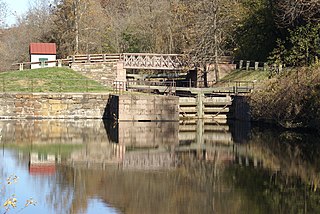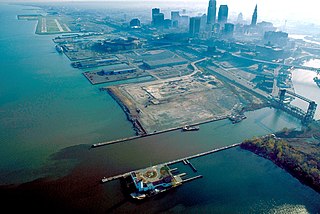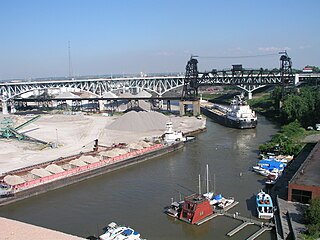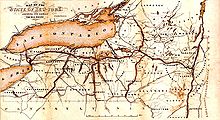
William Magear "Boss" Tweed was an American politician most notable for being the political boss of Tammany Hall, the Democratic Party's political machine that played a major role in the politics of 19th-century New York City and State.

Canals or artificial waterways are waterways or engineered channels built for drainage management or for conveyancing water transport vehicles. They carry free, calm surface flow under atmospheric pressure, and can be thought of as artificial rivers.

The Erie Canal is a historic canal in upstate New York that runs east–west between the Hudson River and Lake Erie. Completed in 1825, the canal was the first navigable waterway connecting the Atlantic Ocean to the Great Lakes, vastly reducing the costs of transporting people and goods across the Appalachians. The Erie Canal accelerated the settlement of the Great Lakes region, the westward expansion of the United States, and the economic ascendancy of New York state. It has been called "The Nation's First Superhighway".

Samuel Jones Tilden was an American politician who served as the 25th governor of New York and was the Democratic nominee in the disputed 1876 United States presidential election.

A container ship is a cargo ship that carries all of its load in truck-size intermodal containers, in a technique called containerization. Container ships are a common means of commercial intermodal freight transport and now carry most seagoing non-bulk cargo.
Tonnage is a measure of the capacity of a ship, and is commonly used to assess fees on commercial shipping. The term derives from the taxation paid on tuns or casks of wine. In modern maritime usage, "tonnage" specifically refers to a calculation of the volume or cargo volume of a ship. Although tonnage (volume) should not be confused with displacement, the long ton of 2,240 lb is derived from the fact that a "tun" of wine typically weighed that much.

Charles Stebbins Fairchild was an American businessman and politician who served as United States Secretary of the Treasury from 1887 to 1889 and Attorney General of New York from 1876 to 1877. He was a notable anti-suffragist, challenging the Nineteenth Amendment to the United States Constitution in 1920 and serving as president of the American Constitutional League.

A bulk carrier or bulker is a merchant ship specially designed to transport unpackaged bulk cargo—such as grain, coal, ore, steel coils, and cement—in its cargo holds. Since the first specialized bulk carrier was built in 1852, economic forces have led to increased size and sophistication of these ships. Today's bulk carriers are specially designed to maximize capacity, safety, efficiency, and durability.

The Delaware and Hudson Railway (D&H) is a railroad that operates in the Northeastern United States. In 1991, after more than 150 years as an independent railroad, the D&H was purchased by the Canadian Pacific Railway (CP). CP, which would itself become part of Canadian Pacific Kansas City in 2023, operated D&H under its subsidiary Soo Line Corporation, which also operates Soo Line Railroad.

The Schuylkill Canal, or Schuylkill Navigation, was a system of interconnected canals and slack-water pools along the Schuylkill River in the U.S. state of Pennsylvania, built as a commercial waterway in the early 19th-century. Chartered in 1815, the navigation opened in 1825, to provide transportation and water power.

An ore dock is a large structure used for loading ore onto ships, which then carry the ore to steelworks or to transshipment points. Most known ore docks were constructed near iron mines on the upper Great Lakes and served the lower Great Lakes. Ore docks still in existence are typically about 60 feet (18 m) wide, 80 feet (24 m) high, and vary from 900 feet (270 m) to 2,400 feet (730 m) in length. They are commonly constructed from wood, steel, reinforced concrete, or combinations of these materials.

An oil tanker, also known as a petroleum tanker, is a ship designed for the bulk transport of oil or its products. There are two basic types of oil tankers: crude tankers and product tankers. Crude tankers move large quantities of unrefined crude oil from its point of extraction to refineries. Product tankers, generally much smaller, are designed to move refined products from refineries to points near consuming markets.

The Port of Cleveland is a bulk freight and container shipping port at the mouth of the Cuyahoga River on Lake Erie in Cleveland, Ohio, United States. It is the third-largest port in the Great Lakes and the fourth-largest Great Lakes port by annual tonnage. Over 20,000 jobs and $3.5 billion in annual economic activity are tied to the roughly 13 million tons of cargo that move through Cleveland Harbor each year.
Robert C. Dorn was an American politician from New York. In 1865, he was elected Canal Commissioner on the Republican ticket. In May 1868, he was put on trial by the Senate of New York in the Court of Impeachment, becoming the second person tried by the New York Court for the Trial of Impeachments.

Day Peckinpaugh is a historic canal motorship berthed at the Matton Shipyard on Peebles Island, Cohoes in Albany County, New York, United States.

Algoma Buffalo, formerly Buffalo, is a diesel-powered lake freighter acquired by Algoma Central Corporation in 2018. This vessel was built in 1978 by Bay Shipbuilding Company at their yard in Sturgeon Bay, Wisconsin for the American Steamship Company and included self-unloading technology. The ship is 634 feet 10 inches (193.50 m) long and 68 feet (21 m) wide, with a carrying capacity of 24,457 tons deadweight (DWT), and is primarily used to ship road salt and construction goods. The vessel is currently in service.
In the United States from the late 18th and 19th centuries, the Industrial Revolution affected the U.S. economy, progressing it from manual labor, farm labor and handicraft work, to a greater degree of industrialization based on wage labor. There were many improvements in technology and manufacturing fundamentals with results that greatly improved overall production and economic growth in the U.S.

Radcliffe R. Latimer is a lake freighter launched in 1978. The vessel is owned by Algoma Central but operated under charter to Canada Steamship Lines from 1994 to 1997. As Algobay, the bulk carrier was involved in a collision with the lake freighter Montrealais in 1980. In 2009 the vessel was rebuilt in China for service in the Caribbean Sea. The vessel is currently in service.

Alfred Kelley was a banker, canal builder, lawyer, railroad executive, and state legislator in the state of Ohio in the United States. He is considered by historians to be one of the most prominent commercial, financial, and political Ohioans of the first half of the 19th century.

SS Selah Chamberlain was a wooden-hulled Great Lakes freighter that sank in Lake Michigan in 1886, 6 miles (10 km) off the coast of Sheboygan, Sheboygan County, Wisconsin, United States after being rammed by the steamer John Pridgeon Jr. with the loss of five lives. On January 7, 2019, the wreck of Selah Chamberlain was listed on the National Register of Historic Places, and was given the reference number 100003288. She was the first shipwreck listed on the National Register of Historic Places in 2019.

















